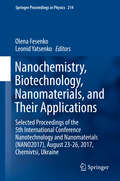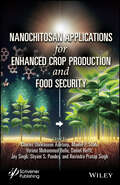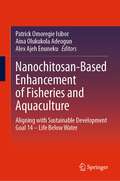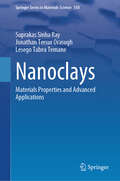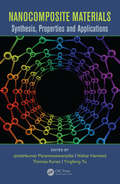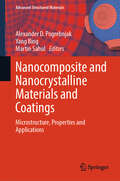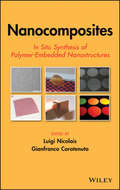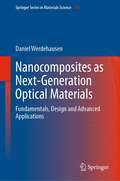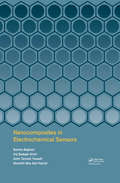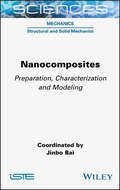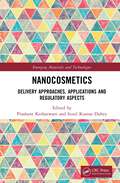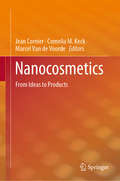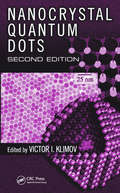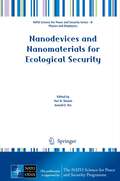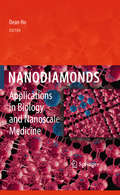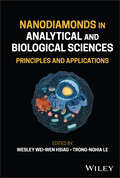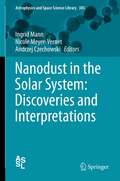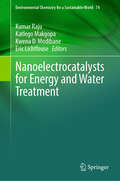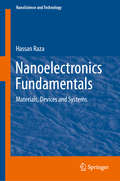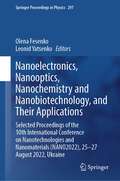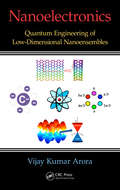- Table View
- List View
Nanochemistry, Biotechnology, Nanomaterials, and Their Applications: Selected Proceedings of the 5th International Conference Nanotechnology and Nanomaterials (NANO2017), August 23-26, 2017, Chernivtsi, Ukraine (Springer Proceedings in Physics #214)
by Leonid Yatsenko Olena FesenkoThis book presents some of the latest achievements in nanotechnology and nanomaterials from leading researchers in Ukraine, Europe, and beyond. It features selected peer-reviewed contributions from participants in the 5th International Science and Practice Conference Nanotechnology and Nanomaterials (NANO2017) held in Chernivtsi, Ukraine on August 23-26, 2017. The International Conference was organized jointly by the Institute of Physics of the National Academy of Sciences of Ukraine, Ivan Franko National University of Lviv (Ukraine), University of Tartu (Estonia), University of Turin (Italy), and Pierre and Marie Curie University (France). Internationally recognized experts from a wide range of universities and research institutions share their knowledge and key results on topics ranging from energy storage to biomedical applications. This book's companion volume also addresses nanooptics, nanoplasmonics, and interface studies.
Nanochitosan Applications for Enhanced Crop Production and Food Security
by Shyam S. Pandey Maulin P. Shah Charles Oluwaseun Adetunji Ravindra Pratap Singh Jay Singh Daniel Hefft Yerima Mohammed BelloThis unique, important, and timely book provides detailed information about the application of nanochitosan to increase agricultural productivity to enhance food security and nutrition. Readers will find in Nanochitosan Applications for Enhanced Crop Production and Food Security detailed state-of-the-art information including: The modes of action through which nanochitosan perform numerous biological activities; State-of-the-art information and recent advancements in the application of nanochitosan, including targeted delivery, genetic manipulation, antimicrobial uses, curing infections in plants, controlled delivery of biologically active constituents, applications in the evaluation of carbon dioxide concentrations and humidity in controlled greenhouse environments, and their use as pressure sensors in agrichemical spraying equipment; Information on applying nanochitosan as a biofertilizer and bioinsecticide when applied on seeds and for foliar spraying of agricultural crops, soil amendment, and protection against pathogens and pests; The application of nanochitosan in the manufacturing of nanosensors in precision farming in the determination of crop growth, condition of soils, penetration of agrochemicals, diseases, and the level of environmental pollution to ensure a high level of safety for plant and soil health. Audience Researchers, scientists, and graduate students in agriculture, crop science, agricultural biotechnology, and agricultural engineering applications of nanochitosan, as well as policymakers, entrepreneurs, and investors in agriculture and food security.
Nanochitosan-Based Enhancement of Fisheries and Aquaculture: Aligning with Sustainable Development Goal 14 – Life Below Water
by Patrick Omoregie Isibor Aina Olukukola Adeogun Alex Ajeh EnunekuNanochitosan-Based Enhancement of Fisheries and Aquaculture: Aligning with Sustainable Development Goal 14 – Life Below Water is an indispensable guide for envisioning an ecologically balanced and prosperous future for aquatic resource management. The book explores the innovative application of nanochitosan in aquatic resource management, delineating the cutting-edge potentials of the novel biopolymer to reshape the landscape of fisheries and aquaculture and align with the ambitions of the United Nations Sustainable Development Goals (Goal 14: Life Below Water). The book focuses on sustainability and showcases nanochitosan's capacity to elevate water quality, bolster aquatic well-being, and revolutionize aquaculture disease control, breeding, detoxification, and feed quality. Through practical applications, interdisciplinary insights, and a strong emphasis on food safety and conservation, readers gain a multifaceted understanding of thefield's advancements, future potential, challenges, and requisite nanochitosan-based techniques. This work navigates complex scientific concepts clearly, catering to a diverse audience, including researchers, practitioners, and students.
Nanoclays: Materials Properties and Advanced Applications (Springer Series in Materials Science #350)
by Suprakas Sinha Ray Lesego Tabea Temane Jonathan Tersur OrasughThis book covers natural and synthetic nanoclays, focusing on the fundamentals of nanoclay-chemistry and applications in advanced technologies. For millennia, clay has been an indispensable part of human civilization, playing an especially fundamental role in modern society in the form of e.g. porcelain, ceramics, bricks, and tiles, as well as being an essential constituent for plastics, paints, paper, rubber, cosmetics, sensors, and medicinal products.The book introduces the reader to nanoclays, most commonly referred to as layered silicates, which take the form of layered or sheet-like structures with nanometer-scale dimensions. It describes the structure and materials properties of both natural and synthetic nanoclays, and covers their applications in diverse areas such as paint formulations, water purification, cosmetics, biomedical applications, and energy storage. Authored by experts with long-standing experience in industry and academic research, this book serves as a useful reference not only for students and academics interested in this exciting new field, but also industrial researchers and R&D managers wishing to bring nanoclay-based advanced products to market.
Nanocomposite Materials: Synthesis, Properties and Applications (Woodhead Publishing Series In Composites Science And Engineering Ser.)
by Jyotishkumar Parameswaranpillai Nishar Hameed Thomas Kurian Yingfeng YuThis book provides a comprehensive collection of the latest information on nanomaterials and nanocomposites. It covers material synthesis, processing, structure characterization, properties and applications. It presents a coherent treatment of how composite properties depend on nanostructure, and covers cutting-edge topics like bionanocomposites for sustainable development. This book summarizes many developments in the field making it an ideal resource for researchers from industry, academia, government and private research institutions.
Nanocomposite Membrane Technology: Fundamentals and Applications
by P.K. TewariNanocomposite Membrane Technology: Fundamentals and Applications is the first book to deliver an extensive exploration of nanocomposite membrane technology. This groundbreaking text offers an eloquent introduction to the field as well as a comprehensive overview of fundamental aspects and application areas. Approaching the subject from the material
Nanocomposite and Nanocrystalline Materials and Coatings: Microstructure, Properties and Applications (Advanced Structured Materials #214)
by Alexander D. Pogrebnjak Yang Bing Martin SahulThis book is a collection of reports (reviewed) selected from several sections of the IEEE Nanomaterials: Application and Properties-2023 conference. The book is devoted to the study of films, coatings, and materials obtained by various methods of preparation and deposition, for example, magnetron sputtering of targets, vacuum arc deposition , electron-plasma processing, sintering of composites, plasma jet deposition, and other methods for obtaining nanomaterials. The chapters and reports describe superhard coatings, spark, and plasma alloying of materials (metals, semiconductors, polymers, ceramics).
Nanocomposites
by Luigi Nicolais Gianfranco CarotenutoA Step-by-step guide to the synthesis and characterization of metal-polymer nanocompositesPolymer nanocomposites, polymers that are reinforced with nano-sized particles, provide enhanced mechanical, thermal, electrical, and barrier properties. Continued research and development of new polymer nanocomposites promises to provide enhanced materials to a broad range of industries, such as plastics, aerospace, automotive, electronics, packaging, and biomedical devices. Structured as a practical laboratory manual, this book enables readers to expertly synthesize and characterize metal-polymer nanocomposites by clearly setting forth the principles and techniques.Nanocomposites: In Situ Synthesis of Polymer-Embedded Nanostructures features contributions from an international team of materials science and nanotechnology experts. Chapters reflect the authors' critical review of the literature as well as their own laboratory experience working with polymer nanocomposites. The book begins with a detailed introduction to the science, properties, and applications of metal-polymer nanocomposites. Next, it covers such topics as:Morphological and topological conceptsPhase separation and nanoparticle aggregationMethods for the synthesis of nanocompositesMorphological controlCharacterization techniques and data analysis methodsToxicity considerationsHigh-resolution images of metal nanoparticles, created by transmission electron microscopy, are provided throughout the book. There are also plenty of process schemes and detailed drawings, helping readers better understand how to synthesize, characterize, and use these composite materials. A bibliography at the end of each chapter provides a gateway to original research papers and reviews in the field.With its focus on the practical steps of synthesis and characterization, Nanocomposites: In Situ Synthesis of Polymer-Embedded Nanostructures is recommended for both students and practitioners in nanotechnology, polymer science, and materials science and engineering.
Nanocomposites as Next-Generation Optical Materials: Fundamentals, Design and Advanced Applications (Springer Series in Materials Science #316)
by Daniel WerdehausenThis book looks at advanced nanocomposites, introducing long-awaited concepts towards bridging the gap between nanostructured optical materials and next-generation imaging systems. It investigates nanocomposites as bulk optical materials and highlights the immense potential they hold for real-world optical elements and systems, such as smartphone cameras. It covers the full spectrum of nanocomposite optical materials from their fundamental properties to analytical modeling and detailed application examples. This book also provides an in-depth discussion of the role these new materials play in the development of broadband flat optics – diffractive optical elements used for enhancing high-end broadband imaging systems. Written by an industry expert, this book seamlessly connects fundamental research and real-world applications. It is the ideal guide both for optical engineers working towards integrating new technologies, and researchers involved with fundamental research on optical materials.
Nanocomposites in Electrochemical Sensors
by Iraj Sadegh Amiri Samira Bagheri Amin Termeh Yousefi Sharifah Bee Abd HamidNanotechnology has become one of the most important fields in science. Nanoparticles exhibit unique chemical, physical and electronic properties that are different from those of bulk materials, due to their small size and better architecture. Nanoparticles can be used to construct novel sensing devices; in particular electrochemical sensors. Electrochemical detection is highly attractive for the monitoring of glucose, cancer cells, cholesterol and infectious diseases. Unique nanocomposite-based films proposed in this book open new doors to the design and fabrication of high-performance electrochemical sensors.
Nanocomposites, Nanostructures, and Their Applications: Selected Proceedings of the 6th International Conference Nanotechnology and Nanomaterials (NANO2018), August 27-30, 2018, Kyiv, Ukraine (Springer Proceedings in Physics #221)
by Leonid Yatsenko Olena FesenkoThis book highlights some of the latest advances in nanotechnology and nanomaterials from leading researchers in Ukraine, Europe, and beyond. It features contributions from participants in the 6th International Science and Practice Conference Nanotechnology and Nanomaterials (NANO2018) in Kiev, Ukraine on August 27-30, 2018 organized by the Institute of Physics of the National Academy of Sciences of Ukraine, University of Tartu (Estonia), University of Turin (Italy), and Pierre and Marie Curie University (France). Internationally recognized experts from a wide range of universities and research institutions share their knowledge and key results on material properties, behavior, and synthesis. This book's companion volume also addresses topics such as nanooptics, energy storage, and biomedical applications.
Nanocomposites: Preparation, Characterization and Modeling
by Jinbo BaiNanocomposites are one of the major advances in the field of materials. They have applications in sectors as varied as aeronautics, energy and the environment. However, the effective use of nanocomposites requires new knowledge and tools in order to overcome the difficulties and benefit from the advantages. Nanocomposites presents recent academic and industrial progress in this field, as well as the latest research on the effective use of nanoscale fillers and reinforcements to improve the performance of advanced nanocomposites. It also describes the techniques and tools used to prepare nanocomposites, including the latest techniques for synthesis and surface treatment of nanofillers for different applications. Finally, it details the role of nanoscience in the design, characterization and multi-scale modeling of these materials, with a focus on nanoscale phenomena.
Nanocosmetics Delivery Approaches, Applications and Regulatory Aspects: Delivery Approaches, Applications And Regulatory Aspects (Emerging Materials and Technologies)
by Prashant Kesharwani Sunil Kumar DubeyThis book offers an overview of the science of cosmetics and the formulation of nanosized cosmetic products including fabrication, characterization of nanocosmetics, major challenges in the safe applications, regulatory aspects, and commercialization on a large scale. The chapters provide understanding of the interaction of nanocarriers with skin and hair, different nanocosmetic products in the present situation, applications as well as disadvantageous toxicity associated with nanocosmetics, regulatory prospects, and future perspectives. Features: Provide an explicit account on vital aspects of various nanocosmetics drug delivery approaches, thereby providing a next-generation cosmetic product. Bring together the novel applications of nanocosmetics approaches in the biological milieu. Explores preparation, applications, toxicity, and regulatory prospects. Includes a dedicated chapter on Niosomal drug-delivery systems in cosmetics. Discusses the perspectives of the technologies explored so far based upon the findings outlined in highly organized tables, illustrative figures, and flow charts. This book is aimed at researchers and professionals in nanomedicine, pharmaceuticals, biotechnology, and the health sector.
Nanocosmetics: From Ideas to Products
by Marcel Van de Voorde Jean Cornier Cornelia M. KeckThis book addresses the application of nanotechnology to cosmetics. Edited by three respected experts in the field, the book begins with a general overview of the science behind cosmetics and skin care today, and of the status quo of nanotechnology in cosmetics. Subsequent chapters provide detailed information on the different nanoparticles currently used in cosmetics; the production and characterization of nanoparticles and nanocosmetics; and regulatory, safety and commercialization aspects. Given its scope, the book offers an indispensable guide for scientists in academia and industry, technicians and students, as well as a useful resource for decision-makers in the field and consumer organizations.Chapter 6 of this book is available open access under a CC BY 4.0 licence at link.springer.com.
Nanocrystal Quantum Dots
by Victor I. KlimovA review of recent advancements in colloidal nanocrystals and quantum-confined nanostructures, Nanocrystal Quantum Dots is the second edition of Semiconductor and Metal Nanocrystals: Synthesis and Electronic and Optical Properties, originally published in 2003. This new title reflects the book’s altered focus on semiconductor nanocrystals. Gathering contributions from leading researchers, this book contains new chapters on carrier multiplication (generation of multiexcitons by single photons), doping of semiconductor nanocrystals, and applications of nanocrystals in biology. Other updates include: New insights regarding the underlying mechanisms supporting colloidal nanocrystal growth A revised general overview of multiexciton phenomena, including spectral and dynamical signatures of multiexcitons in transient absorption and photoluminescence Analysis of nanocrystal-specific features of multiexciton recombination A review of the status of new field of carrier multiplication Expanded coverage of theory, covering the regime of high-charge densities New results on quantum dots of lead chalcogenides, with a focus studies of carrier multiplication and the latest results regarding Schottky junction solar cells Presents useful examples to illustrate applications of nanocrystals in biological labeling, imaging, and diagnostics The book also includes a review of recent progress made in biological applications of colloidal nanocrystals, as well as a comparative analysis of the advantages and limitations of techniques for preparing biocompatible quantum dots. The authors summarize the latest developments in the synthesis and understanding of magnetically doped semiconductor nanocrystals, and they present a detailed discussion of issues related to the synthesis, magneto-optics, and photoluminescence of doped colloidal nanocrystals as well. A valuable addition to the pantheon of literature in the field of nanoscience, this book presents pioneering research from experts whose work has led to the numerous advances of the past several years.
Nanodevices and Nanomaterials for Ecological Security
by Arnold E. Kiv Yuri N. ShuninThis book is devoted to a wide range of problems concerning applications of nanomaterials and nanodevices as effective solutions to modern ecological problems. Leading experts in nanoscience and nanotechnology present the key theoretical, experimental and implementation issues related to the creation and utilization of novel nanoscale devices to help ensure ecological security. The authors discuss appropriate nanotechnologies for minimizing various types of risk: to human life, technogenic risk, or indeed terrorist threats. Particular emphasis is placed on defining and studying the required materials properties, and - in the field - on nanoscale devices for sensors and monitoring.
Nanodiamonds
by Dean HoNanodiamonds: Applications in Biology and Nanoscale Medicine highlights the translation of nanodiamonds toward clinical relevance and medical applications. Integrating a spectrum of internationally-recognized experts currently developing these technologies, this book fits as a cornerstone of this exciting field. These include contributions from clinician scientists working at the interface of medicine and nanotechnologies which discuss the critical and requisite properties of nanomaterials, in a concise and cohesive manner. Nanodiamonds: Applications in Biology and Nanoscale Medicine provides a multidisciplinary overview of nanodiamonds and there uses for scientific, engineering and clinical audiences alike.
Nanodiamonds in Analytical and Biological Sciences: Principles and Applications
by Wesley Wei-Wen Hsiao Trong-Nghia LeNANODIAMONDS IN ANALYTICAL AND BIOLOGICAL SCIENCES Comprehensive resource highlighting the significance and applications of fluorescent and non-fluorescent nanodiamonds in various domains Nanodiamonds in Analytical and Biological Sciences combines the disciplines of chemistry, physics, materials science, and biology to demonstrate the significance of nanodiamonds, offering precise analysis of the impacts and up-to-date applications of fluorescent and non-fluorescent nanodiamonds, including in COVID-19 and artificial intelligence, with illustrations, case studies, practical examples, and novel perspectives included throughout. Edited by two highly qualified scholars with significant experience in the field, topics covered include: Fundamental properties, synthesis, mechanisms, and functionalization of nanodiamonds, and toxicity assessment Fabrication and surface modification of fluorescent nanodiamonds and in vitro and in vivo bioimaging of fluorescent nanodiamonds Nanodiamond-enabled drug delivery and nanodiamond for mass spectrometry-based analysis of peptides, proteins, and proteomes Quantum sensing, applications in physico-chemical and biomedical sensing, and perspective and outlook on the future of nanodiamond research Nano-scale thermometry of fluorescent nanodiamonds and nanodiamond-enabled drug delivery Offering a balanced, multidisciplinary, and comprehensive overview of the significance of fluorescent and non-fluorescent nanodiamonds, Nanodiamonds in Analytical and Biological Sciences is an essential resource for academic researchers and industry professionals working in fields spanning chemistry, physics, materials science and biology.
Nanodust in the Solar System: Discoveries and Interpretations
by Andrzej Czechowski Ingrid Mann Nicole Meyer-VernetNanodust and nanometer-sized structures are important components of many objects in space. Nanodust is observed in evolved stars, young stellar objects, protoplanetary disks, and dust debris disks. Within the solar system, nanodust is observed with in-situ experiments from spacecraft. Nanometer-sized substructures are found in the collected cometary and interplanetary dust particles and in meteorites. Understanding the growth and destruction of dust, its internal evolution, as well as the optical properties and the detection of nanoparticles is of fundamental importance for astrophysical research. This book provides a focused description of the current state of research and experimental results concerning nanodust in the solar system. It addresses three major questions: What is nanodust? How was it discovered in the solar system? And how do we interpret the observations? The book serves as a self-contained reference work for space researchers and provides solid information on nanodust in cosmic environments for researchers working in astrophysics or in other fields of physics.
Nanoelectrocatalysts for Energy and Water Treatment (Environmental Chemistry for a Sustainable World #74)
by Eric Lichtfouse Kumar Raju Katlego Makgopa Kwena D. ModibaneNanomaterials have recently garnered significant attention and practical importance for heterogeneous electrocatalysis. This book presents recent developments in the design, synthesis, and characterisation of nanostructured electrocatalytic materials, with a focus on applications to energy and wastewater treatment. Electrocatalytic nanomaterials can enhance process efficiency and sustainability, thus providing innovative solutions for a wide array of areas such as sustainable energy production, conversion, and wastewater treatment. Readers will gain insights into the latest breakthroughs in electrocatalysis and the activity of nanomaterials in energy conversion applications, e.g., fuel cells, hydrogen production, water splitting, and electro/photocatalytic water splitting, as well as for wastewater treatment. The book explores the development of advanced electrocatalysts, particularly hybrid materials.
Nanoelectrochemistry
by Michael V. Mirkin Shigeru AmemiyaNanoscale electrochemistry has revolutionized electrochemical research and technologies and has made broad impacts in other fields, including nanotechnology and nanoscience, biology, and materials chemistry. Nanoelectrochemistry examines well-established concepts and principles and provides an updated overview of the field and its applications.This
Nanoelectromechanics in Engineering and Biology (Nano- and Microscience, Engineering, Technology and Medicine)
by Michael Pycraft HughesThe success, growth, and virtually limitless applications of nanotechnology depend upon our ability to manipulate nanoscale objects, which in turn depends upon developing new insights into the interactions of electric fields, nanoparticles, and the molecules that surround them. In the first book to unite and directly address particle electrokinetics and nanotechnology, Nanoelectromechanics in Engineering and Biology provides a thorough grounding in the phenomena associated with nanoscale particle manipulation. The author delivers a wealth of application and background knowledge, from using electric fields for particle sorting in lab-on-a-chip devices to electrode fabrication, electric field simulation, and computer analysis. It also explores how electromechanics can be applied to sorting DNA molecules, examining viruses, constructing electronic devices with carbon nanotubes, and actuating nanoscale electric motors. The field of nanotechnology is inherently multidisciplinary-in its principles, in its techniques, and in its applications-and meeting its current and future challenges will require the kind of approach reflected in this book. Unmatched in its scope, Nanoelectromechanics in Engineering and Biology offers an outstanding opportunity for people in all areas of research and technology to explore the use and precise manipulation of nanoscale structures.
Nanoelectronics Fundamentals: Materials, Devices and Systems (NanoScience and Technology)
by Hassan RazaThis book covers the state of the art in the theoretical framework, computational modeling, and the fabrication and characterization of nanoelectronics devices. It addresses material properties, device physics, circuit analysis, system design, and a range of applications. A discussion on the nanoscale fabrication, characterization and metrology is also included. The book offers a valuable resource for researchers, graduate students, and senior undergraduate students in engineering and natural sciences, who are interested in exploring nanoelectronics from materials, devices, systems, and applications perspectives.
Nanoelectronics, Nanooptics, Nanochemistry and Nanobiotechnology, and Their Applications: Selected Proceedings of the 10th International Conference on Nanotechnologies and Nanomaterials (NANO2022), 25–27 August 2022, Ukraine (Springer Proceedings in Physics #297)
by Leonid Yatsenko Olena FesenkoThis book highlights some of the latest advances in nanotechnology and nanomaterials from leading researchers in Ukraine, Europe and beyond. It features contributions presented at the 10th International Science and Practice Conference Nanotechnology and Nanomaterials (NANO2022), which was held on August 25-27, 2022 at Lviv House of Scientists, and was jointly organized by the Institute of Physics of the National Academy of Sciences of Ukraine, University of Tartu (Estonia), University of Turin (Italy), and Pierre and Marie Curie University (France). Internationally recognized experts from a wide range of universities and research institutions share their knowledge and key findings across diverse areas ranging from quantum optics and nanoelectonics to biophysics.The book will be interesting for leading scientists, advanced undergraduate and graduate students in nanoelectronics, optics, bio-and chemical engineering. This book’s companion volume also addresses topics such as nanostructured surface, nanomaterials, and its applications.
Nanoelectronics: Quantum Engineering of Low-Dimensional Nanoensembles
by Vijay Kumar AroraBrings the Band Structure of Carbon-Based Devices into the LimelightA shift to carbon is positioning biology as a process of synthesis in mainstream engineering. Silicon is quickly being replaced with carbon-based electronics, devices are being reduced down to nanometer scale, and further potential applications are being considered. While traditionally, engineers are trained by way of physics, chemistry, and mathematics, Nanoelectronics: Quantum Engineering of Low-Dimensional Nanoensembles establishes biology as an essential basic science for engineers to explore. Unifies Science and Engineering: from Quantum Physics to NanoengineeringDrawing heavily on published papers by the author, this research-driven text offers a complete review of nanoelectronic transport starting from quantum waves, to ohmic and ballistic conduction, and saturation-limited extreme nonequilibrium conditions. In addition, it highlights a new paradigm using non-equilibrium Arora’s Distribution Function (NEADF) and establishes this function as the starting point (from band theory to equilibrium to extreme nonequilibrium carrier statistics). The author focuses on nano-electronic device design and development, including carbon-based devices, and provides you with a vantage point for the global outlook on the future of nanoelectronics devices and ULSI.Encompassing ten chapters, this illuminating text: Converts the electric-field response of drift velocity into current–voltage relationships that are driven by the presence of critical voltage and saturation current arising from the unidirectional drift of carriers Applies the effect of these scaled-down dimensions to nano-MOSFET (metal–oxide–semiconductor field-effect transistor) Considers specialized applications that can be tried through a number of suggested projects that are all feasible with MATLAB® codes Nanoelectronics: Quantum Engineering of Low-Dimensional Nanoensembles contains the latest research in nanoelectronics, identifies problems and other factors to consider when it comes to nanolayer design and application, and ponders future trends.Print Versions of this book also include access to the ebook version.
